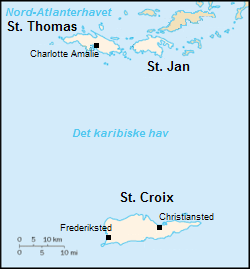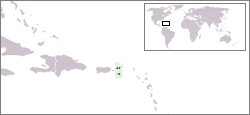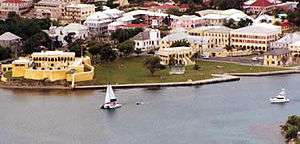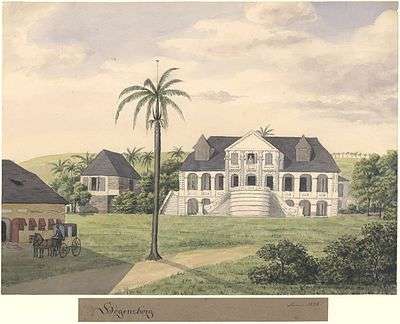Danish West Indies
| Danish West Indies Dansk Vestindien | |||||||||
|---|---|---|---|---|---|---|---|---|---|
| 1754–1917 | |||||||||
 | |||||||||
 | |||||||||
 | |||||||||
| Status |
Colony of Denmark-Norway (1754–1814) Colony of Denmark (1814–1917) | ||||||||
| Capital |
Charlotte Amalie (1672–1754 and 1871–1917) Christiansted (1754–1871) | ||||||||
| Common languages | Danish, English | ||||||||
| Governor-General | |||||||||
• 1756–66 | Christian Leberecht von Prøck (first) | ||||||||
• 1916–17 | Henri Konow (last) | ||||||||
| History | |||||||||
• Sold by the Danish West India Company | 1754 | ||||||||
| March 31 1917 | |||||||||
| Area | |||||||||
| [1] | 400 km2 (150 sq mi) | ||||||||
| Population | |||||||||
• 1911[1] | 27000 | ||||||||
| Currency |
Rigsdaler (1754–1849) Daler (1849–1917) | ||||||||
| |||||||||
The Danish West Indies (Danish: Dansk Vestindien) or Danish Antilles was a Danish colony in the Caribbean, consisting of the islands of Saint Thomas with 32 square miles (83 km2); Saint John with 19 square miles (49 km2); and Saint Croix with 84 square miles (220 km2). The Danish West India Guinea Company annexed the uninhabited island of Saint Thomas[2] in 1672 and St. John in 1675. In 1733, Saint Croix was purchased from the French West India Company. When the Danish company went bankrupt in 1755, the King of Denmark-Norway assumed direct control of the three islands. Britain occupied the Danish West Indies in 1801–02 and 1807–15, during the Napoleonic Wars.
Danish colonizers in the West Indies aimed to exploit the profitable triangular trade, involving the export of firearms and other manufactured goods to Africa in exchange for slaves who were then transported to the Caribbean to work the sugar plantations. The final stage of the triangle involved the export of cargos of sugar and rum to Denmark. The economy of the Danish West Indies depended on slavery. After a rebellion, slavery was officially abolished in 1848, leading to the near economic collapse of the plantations.
In 1852 the Danish parliament first debated the sale of the increasingly unprofitable colony. Denmark tried several times to sell or exchange the Danish West Indies in the late 19th and early 20th centuries: to the United States and to the German Empire respectively. The islands were eventually sold for 25 million dollars to the United States, which took over the administration on 31 March 1917, renaming the islands the United States Virgin Islands.
History
Foundation
Merchants in Copenhagen asked King Christian IV for permission to establish a West Indian trading company in 1622, but by the time an eight-year monopoly on trade with the West Indies, Virginia, Brazil, and Guinea was granted on 25 January 1625, the failure of the Danish East India and Iceland Companies and the beginning of Danish involvement in the Thirty Years' War dried up any interest in the idea. Prince Frederick organized a trading mission to Barbados in 1647 under Gabriel Gomez and the de Casseres brothers, but it and a 1651 expedition of two ships were unsuccessful. It was not until Erik Smit's private 1652 expedition aboard the Fortuna was successful that interest in the West Indies' trade grew into an interest in the creation of a new Danish colony.[3]
Smit's 1653 expedition and a separate expedition of five ships were quite successful, but Smit's third found his two vessels captured for a loss of 32,000 rigsdaler. In August two years later, a Danish Flotilla was destroyed by a hurricane. Smit returned from his fourth expedition in 1663 and formally proposed the settlement of St. Thomas to the king in April 1665. After only three weeks' deliberation, the scheme was approved and Smit was named governor. Settlers departed aboard the Eendragt on 1 July, but the expedition was ill-starred: the ship hit two large storms and suffered from fire before reaching its destination, and then it was raided by English privateers prosecuting the Second Anglo-Dutch War. Smit died of illness, and a second band of privateers stole the ship and used it to trade with neighboring islands. Following a hurricane and a renewed outbreak of disease, the colony collapsed, with the English departing for the nearby French colony on Sainte-Croix, the Danes fleeing to Saint Christopher, and the Dutch assisting their countrymen on Ter Tholen in stealing everything of value, particularly the remaining Danish guns and ammunition.[3]
Danish West India Company

The Danish formed a Board of Trade in 1668 and secured a commercial treaty with Britain, providing for the unmolested settlement of uninhabited islands, in July 1670. The Danish West India Company was organized in December and formally chartered by King Christian V the next year on March 11, 1671.[4] Jørgen Iversen Dyppel, a successful trader on Saint Christopher, was made governor and the king provided convicts from his jails and two vessels for the establishment of the colony, the yacht Den forgyldte Krone[5][6] and the frigate Færøe.[7][8] Den forgyldte Krone was ordered to run ahead and wait but ended up returning to Denmark after the Færøe under Capt. Zacharias Hansen Bang was delayed for repairs in Bergen. The Færøe completed her mission alone, establishing a settlement on St. Thomas on May 25, 1672. From an original contingent of 190 – 12 officials, 116 company "employees" (indentured servants), and 62 felons and former prostitutes – only 104 remained, 9 having escaped and 77 having died in transit. Another 75 died within the first year, leaving only 29 to carry on the colony.[3]
In 1675, Iversen claimed St. John and placed two men there; in 1684, Governor Esmit granted it to two English merchants from Barbados but their men were chased off the island by two British sloops sent by Governor Stapleton of the British Leeward Islands. Further instructions in 1688 to establish a settlement on St. John seem not to have been acted on until Governor Bredal made an official establishment on March 25, 1718.[3]
The islands quickly became a base for pirates attacking ships in the vicinity and also for the Brandenburg African Company. Governor Lorentz raised enormous taxes upon them and seized warehouses and cargoes of tobacco, sugar, and slaves in 1689 only to have his actions repudiated by the authorities in Copenhagen; his hasty action to seize Crab Island prohibited the Brandenburgers from establishing their own Caribbean colony, however. Possession of the island was subsequently disputed with the Scottish in 1698 and fully lost to the Spanish in 1811.
St. Croix was purchased from the French West Indies Company in 1733. In 1754, the islands were sold to the Danish king, Frederick V of Denmark, becoming royal Danish colonies.
Later history (1801–1917)
The first British invasion and occupation of the Danish West Indies occurred during the French Revolutionary Wars when at the end of March 1801 a British fleet arrived at St Thomas. The Danes accepted the Articles of Capitulation the British proposed and the British occupied the islands without a shot being fired. The British occupation lasted until April 1802, when the British returned the islands to Denmark.
The second British invasion of the Danish West Indies took place during the Napoleonic Wars in December 1807 when a British fleet captured St Thomas on 22 December and Saint Croix on 25 December. The Danes did not resist and the invasion was bloodless. This British occupation of the Danish West Indies lasted until 20 November 1815, when Britain returned the islands to Denmark.
By the 1850s the Danish West Indies had a total population of about 41,000 people. The government of the islands were under a governor-general, whose jurisdiction extended to the other Danish colonies of the group. However, because the islands formerly belonged to Great Britain the inhabitants were English in customs and in language. The islands of that period consisted of:[9]
- St. Thomas had a population of 12,800 people and had sugar and cotton as its chief exports. St. Thomas city was the capital of the island, then a free port, and the chief station of the steam-packets between Southampton, in England, and the West Indies.
- St. John had a population of about 2,600 people.[10]
- St. Croix, though inferior to St. Thomas in commerce, was of greater importance in extent and fertility, and, with 25,600 people, was the largest in terms of population.
On 17 January 1917, according to the Treaty of the Danish West Indies, the Danish government sold the islands to the United States for $25 million ($478 million in current prices), when the United States and Denmark exchanged their respective treaty ratifications. Danish administration ended on 31 March 1917, when the United States took formal possession of the territory and renamed it the United States Virgin Islands.
The United States had been interested in the islands since at least the 1860s. The United States finally acted in 1917 because of the islands' strategic position near the approach to the Panama Canal and because of a fear that Germany might seize them to use as U-boat bases during World War I.
Postage stamps
St Thomas was a hub of the West Indies packet service from 1851 to 1885. Denmark issued stamps for the Danish West Indies from 1856 onward.
Religion
The Danish West Indies were inhabited by many different cultures, and each had its own traditions and religions. The king and the church worked closely together to maintain law and order; the church was responsible for people's moral upbringing, and the King led the civil order. There was no state-sponsored religion in Denmark until 1849, but in the Danish West Indies there had always been a great deal of religious freedom. Danish authorities tended to be lenient towards religious beliefs, but required that all citizens had to observe Danish holidays. Freedom of religion was partially granted to help settle the islands, as there was a shortage of willing settlers from Europe. This worked to an extent, seeing that a large proportion of settlers were in fact Dutch and British natives fleeing religious persecution.[11]
Jews began settling the colony in 1655, and by 1796 the first synagogue was inaugurated. In its heyday in the mid-19th century, the Jewish community made up half of the white population.[12] One of the earliest colonial governors, Gabriel Milan, was a Sephardic Jew.
In spite of a general tolerance for religion, many African religions were not recognized because they typically revolved around belief in animism and magic, beliefs which were consistently met with scorn, and were regarded as immoral and subservient. A widespread viewpoint was that if you could convert slaves to Christianity, they could have a better life, and therefore many slaves were converted.[11]
By 1900, with a population of 30,000, a fourth of the people were Roman Catholics, along with Anglicans, and some Moravians and other Protestant groups. For decades the Moravians had organized missions and also taken charge of the educational system.[13]
Slavery and property rights
Laws and regulations in the Danish West Indies were based on Denmark's laws, but the local government was allowed to adapt them to match local conditions. For example, things like animals, land, and buildings were regulated according to Danish law, but Danish law did not regulate slavery. Slaves were treated as common property, and therefore did not necessitate specific laws.

In 1733, differentiation between slaves and other property was implied by a regulation that stated that slaves had their own will and thus could behave inappropriately or be disobedient.[14] The regulation also stated that the authorities were to punish slaves for participating in illegal activity, but many owners punished slaves on their own. There was a general consensus that if the slaves were punished too hard or were malnourished, the slaves would start to rebel. This was born out by the 1733 slave insurrection on St. John where many plantation owners and their families were killed by the Akwamu, including Breffu, before it was suppressed later the following year.[15] In 1755 Frederick V of Denmark issued more new Regulations, in which slaves were guaranteed the right not to be separated from their children and the right to medical support during periods of illness or old age. However, the colonial government had the ability to amend laws and regulations according to local conditions, and thus the regulations were never enacted in the colony, on grounds that it was more disadvantageous than advantageous.[14]
By 1778, it was estimated that the Danish were bringing about 3,000 Africans to the Danish West Indies yearly for enslavement.[16] These transports continued until the end of 1802 when a law by Crown Prince Regent Frederik that banned the trade of slaves came into effect.[17]
When Denmark abolished slavery in 1848, many plantation owners wanted full reimbursement on the grounds that their assets were damaged by the loss of the slaves, and by the fact that they would have to pay for labor in the future. The Danish government paid fifty dollars for every slave the plantation owners had owned and recognized that the slaves' release had caused a financial loss for the owners.[14] However, the lives of the former slaves changed very little. Most were simply hired at the plantations where they had previously worked and were offered one-year contracts, a small hut, a little land and some money as part of a sharecropping system. However, as employees, former slaves were not the plantation owners' responsibility and did not receive food or care from their employers.
See also
References
- 1 2 "Dansk Vestindia". Caplex. Retrieved 21 May 2010.
- ↑
Dookhan, Isaac (1994) [1974]. "3: Danish Colonial Expansion". A History of the Virgin Islands of the United States. Kingston, Jamaica: Canoe Press. p. 40. ISBN 9789768125057. Retrieved 2017-09-07.
The Danes found no one living on St. Thomas when they landed. The English settlers who had occupied the island after the end of the first Danish settlement, had left six or seven weeks before, though the reason for their departure is not known. [...] Denmark's long association with the Virgin Islands began with this occupation of St. Thomas in 1672.
- 1 2 3 4 Dookhan, Isaac. A History of the Virgin Islands of the United States. Canoe Press, 1974. ISBN 9768125055.
- ↑ Westergaard, Waldemar. The Danish West Indies under Company Rule.
- ↑ Also translated as the Golden Crown and the Gilded Crown.
- ↑ Marcussen, Jørgen. "De Vestindiske Øer - kronologisk historisk oversigt" ["The West Indies: A Chronological Historical Overview"]. (in Danish)
- ↑ Also written Færø, Fero, Faero, and Pharaoh.
- ↑ Orlogsmuseet. "Færøe ex-Agathe (1653)".
- ↑ Stewart, K. J., (1864). A Geography for Beginners. Richmond, Va: J W Randolph.
- ↑ DK (2017-03-30). What's Where on Earth? Atlas: The World as You've Never Seen It Before!. Dorling Kindersley Limited. ISBN 9780241308691.
- 1 2 "History: St. Criox, United States Virgin Islands Archived 2012-01-14 at the Wayback Machine. Retrieved On 14 January 2012
- ↑ http://www.jewishvirginislands.com/templates/articlecco_cdo/aid/291284/jewish/Jewish-History-on-Island.htm
- ↑ Kenneth Scott Latourette, Christianity in a Revolutionary Age, III: The Nineteenth Century Outside Europe: The Americas, the Pacific, Asia and Africa. (1961) pp 278-79
- 1 2 3 "Begivenheder 1733" Archived 2012-01-21 at the Wayback Machine., SurtSødt Leksikon, Retrieved On 26 November 2007, In Danish
- ↑ Holly Kathryn Norton (2013). Estate by Estate: The Landscape of the 1733 St. Jan Slave Rebellion (PhD). Syracuse University. p. 90.
- ↑ Kitchin, Thomas (1778). The Present State of the West-Indies: Containing an Accurate Description of What Parts Are Possessed by the Several Powers in Europe. London: R. Baldwin. p. 21.
- ↑ Gøbel, Erik. "Danish Shipping along the Triangular Route, 1671–1802". Scandinavian Journal of History, Vol. 36, No. 2 (2011).
Bibliography
- Jensen, Niklas Thode; Simonsen, Gunvor. "Introduction: The historiography of slavery in the Danish-Norwegian West Indies, c. 1950-2016." Scandinavian Journal of History Sep-Dec2016, Vol. 41 Issue 4/5, p475-494.
External links
| Wikimedia Commons has media related to Danish West Indies. |
- World Statesman
- Transfer Day. From the website of Denmark's consulate on Virgin Islands on the transfer of the Virgin Islands from Denmark to the United States in 1917.
- Reminiscences of a 46 years' residence in the island of St. Thomas, in the West Indies, by Johan Peter Nissen, (1838), a history of the Danish West Indies from 1792-1838.
-2_Dalere_(1898).jpg)
